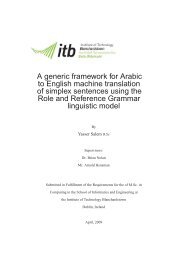On the occurrence and consequences of inaccurate ... - Acsu Buffalo
On the occurrence and consequences of inaccurate ... - Acsu Buffalo
On the occurrence and consequences of inaccurate ... - Acsu Buffalo
Create successful ePaper yourself
Turn your PDF publications into a flip-book with our unique Google optimized e-Paper software.
E.R. Odders-White / Journal <strong>of</strong> Financial Markets 3 (2000) 259}286 269<br />
Table 3<br />
Breakdown by transaction price in relation to quotes<br />
The table below contains a breakdown <strong>of</strong> <strong>the</strong> accuracy <strong>of</strong> <strong>the</strong> Lee <strong>and</strong> Ready algorithm by price<br />
(relative to <strong>the</strong> posted quotes). Each row presents <strong>the</strong> number <strong>and</strong> percentage <strong>of</strong> transactions in that<br />
category that were correctly <strong>and</strong> incorrectly classi"ed. Summing along each row provides <strong>the</strong> total<br />
number <strong>of</strong> transactions falling into <strong>the</strong> respective category. (Percentages sum to 100% along each<br />
row.) Summing down a &Number' column yields <strong>the</strong> total number <strong>of</strong> correctly classi"ed <strong>and</strong><br />
incorrectly classi"ed transactions in <strong>the</strong> sample. Analyses are based only on transactions for which<br />
<strong>the</strong> true initiator can be determined. The Chi-square statistic tests <strong>the</strong> hypo<strong>the</strong>sis that <strong>the</strong> frequency<br />
<strong>of</strong> misclassi"cation is independent <strong>of</strong> price.<br />
Sample Correct Incorrect<br />
Number Percent Number Percent<br />
At or outside <strong>the</strong> quotes 231,308 89.60 26,834 10.40<br />
Inside <strong>the</strong> spread but non-midpoint 7389 78.23 2056 21.77<br />
At <strong>the</strong> spread midpoint 31,804 62.63 18,973 37.37<br />
"24,507.472 p-value"0.001<br />
Since <strong>the</strong> algorithms are best suited for transactions at <strong>the</strong> quotes, small<br />
transactions may be misclassi"ed more <strong>of</strong>ten than larger transactions.<br />
Frequent trading may lead to higher misclassi"cation rates for several reasons.<br />
First, if <strong>the</strong> 5 second rule is not appropriate, its use may induce misclassi"cation<br />
by misaligning <strong>the</strong> quotes <strong>and</strong> trades. Second, <strong>the</strong> presence <strong>of</strong> a more active crowd<br />
on <strong>the</strong> trading #oor for frequently-traded stocks may mean that more trades<br />
occur inside <strong>the</strong> spread, leading to higher misclassi"cation rates. Finally, <strong>the</strong><br />
rapidly changing quotes that stem from frequent trading may be problematic<br />
since <strong>the</strong> Lee <strong>and</strong> Ready algorithm <strong>of</strong>ten uses <strong>the</strong> quotes as a reference point.<br />
Firm size is <strong>of</strong>ten viewed as a proxy for asymmetric information. If larger<br />
"rms pose greater (lesser) adverse selection risks to market makers, <strong>the</strong>n price<br />
improvement may be less (more) likely to occur. Consequently, transactions in<br />
large stocks would take place at <strong>the</strong> posted quotes more (less) <strong>of</strong>ten <strong>and</strong> would<br />
be misclassi"ed less (more) frequently as a result. In addition, <strong>the</strong> strong<br />
correlation between "rm size <strong>and</strong> overall trading activity suggests that large<br />
stocks may be misclassi"ed more <strong>of</strong>ten.<br />
To test <strong>the</strong>se hypo<strong>the</strong>ses, I divide my sample along four dimensions: trade<br />
size, time between trades, number <strong>of</strong> transactions during <strong>the</strong> sample period, <strong>and</strong><br />
"rm size. Table 4 contains <strong>the</strong> results. The statistics in Panel A demonstrate<br />
Transactions were also broken down by <strong>the</strong> day <strong>of</strong> <strong>the</strong> week <strong>and</strong> time <strong>of</strong> day to examine whe<strong>the</strong>r<br />
any relation exists between interday <strong>and</strong> intraday trading patterns <strong>and</strong> misclassi"cation. No<br />
signi"cant patterns emerged across days <strong>of</strong> <strong>the</strong> week, but transactions in <strong>the</strong> morning were<br />
misclassi"ed more frequently than those later in <strong>the</strong> day (16.31% at or before noon vs. 14.39% after<br />
noon), due in part to higher activity in <strong>the</strong> morning.
















